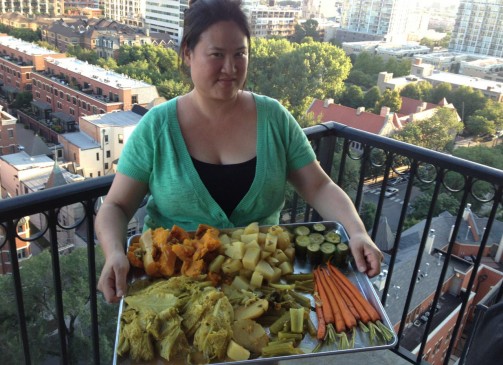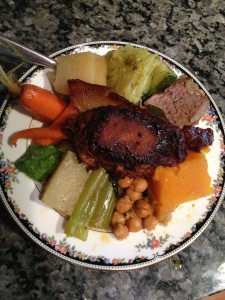By Alan Lake (jazzfood)

Editor’s Note: This article is the second in a series by Alan Lake, all about home cooks, their stories and recipes. Read part one here for a description of what Home Cookin’ is all about.
Alan Lake: Intro
When I think who in my life best represents the spirit I hope to encapsulate in this series, one name leaps to mind: trixie-pea, a.k.a. Kristina Meyer.
We’re connected, she and I, and think we both knew it the minute we met. Over the years I’ve been the recipient of numerous trixie-pea throw-downs. Not many people I know can pull off an elaborate Burmese picnic the way she recently did, putting together a spread of nearly a dozen dishes at a remote, outdoor location. And maybe none of those involved could tell how authentic it was, but one thing we did agree upon was just how effing fabulous it all tasted. Like everything she makes.
Possessor of a palate able to understand sophisticated flavor profiles, with the keen balance of a culinary gymnast, the soul of a kitchen artist, and the ability to create dishes that reflect them, Kristina was a no-brainer for this segment of Home Cookin’.
In keeping with this theme, I’m looking for a story behind the food – the reason you cook a particular dish for the people you love, and the feelings it evokes when you do. Remember, it’s not enough to be delicious. We’re searching for food cooked in a reverential manner, with a poignant or interesting backstory. A dish that has, as its main ingredient, a certain something that makes a recipe more than the sum of its parts – love.
So Kristina and I decided to give you a traditional Tunisian Sabbath meal of Couscous with Boulettes and Vegetables, as interpreted by one of the gourmandiest girls I know: trixie-pea.
Kristina Meyer: My Story
Couscous is not just a family heirloom recipe, but an event in the Sephardic Jewish Lopata household (the family of my long-time significant other, Rob Lopata). Cousins drive in from New York, obligations are cancelled, and anticipation can mount for weeks. This revered dish has passed through the generations, from Rob’s maternal grandmother Meme (and her sisters) to Rob’s mom, Coco.
Coco grew up in Tunis and emigrated to the U.S. when she was 14. While in Tunis, Coco’s sister Rosie fell in love with an American G.I. and decided to move to the U.S. to start anew. The rest of her family fled to Paris after World War II, but Coco, her brother Raymond and their mom Meme came with Rosie by boat to the U.S., landing first at Ellis Island and then settling in Chicago via Lima, Ohio.
KRISTINA’S RECIPE:
Family lore has it that Uncle Ray, lamenting the sorry state of what passed for bread in Ohio, insisted that the family move to a real city with real bread. And Chicago was the closest big city.
When I came into the picture, Meme had passed away and Coco and her sisters weren’t making the labor-intensive, multi-day project much anymore.
I was lucky enough to have tasted it once in its full glory – richly flavored broth made from beef shanks braised with coriander, turmeric, tomato and onions, which steam and perfume the couscous from below. Vegetables like squash, cabbage and kohlrabi are cooked until very soft in this same golden broth. Al dente is not welcome here.
But the boulettes are the star of the show: oblong beef meatballs wrapped in sheaths of potato, eggplant or zucchini, dipped in flour and egg and fried brown, like a meatball Francaise. Then they’re braised until tender with broth reducing slowly, creating an aromatic gravy that lightly coats them.
The couscous is moistened with the broth and presented on platters with the vegetables and boulettes surrounding it. Harissa (Tunisian hot sauce) is served, along with ever-changing array of tapas-like salads that may include cumin and lemon-scented carrots, garlicky roasted eggplant, and assorted olives.
It had always seemed like such a beloved ritual that I thought I shouldn’t attempt to make this food of Rob’s childhood, to which he attached so much importance and love. When he was eight, he’d stand on a chair in the kitchen while Meme prepared the meal, taking notes on index cards as if trying to preserve the magic of the dish by transcribing it for safe-keeping.
But, realizing I wasn’t going to have endless Sabbaths to absorb the wisdom of his mother’s kitchen, I thought – what did I have to lose?
There was no written recipe to work from, just advice and general direction from Coco. Mostly I just made it over and over again for Rob and although he’d devour it every time, he’d also offer little tips to help me tweak it closer to Meme’s. Now, years later, I have my own distinct version that I’ve even made for Rob’s family – a tough audience to say the least. And I haven’t been run out of town!
What I realized in my attempt to clone this dish was that it wasn’t important to make it taste exactly how Rob remembered it. What made it authentic was the fact that I understood the specialness, the sacredness, of the dish and prepared it with that intention – with respect.
For me, this is where the fundamental beauty lies in cooking: the intimate and essential act of feeding someone, whether it be a simple meal or a celebratory feast, that when done with care and love nourishes the body – and so much more!
Alan Lake: Afterword
How appropriate then, that when Kristina and I finally got together to cook this meal it happened to be Friday afternoon. Sabbath dinner, here we come. We didn’t light candles as is traditional, but we felt illuminated nonetheless.
And Rob? No, he didn’t stand on a chair taking notes, but I could tell that she’d hit his sweet spot. She’d hit mine as well. And isn’t that the point?
Shabbat shalom.


